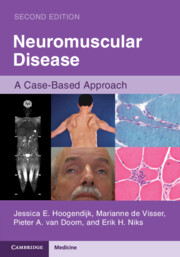Book contents
- Neuromuscular Disease: A Case-Based Approach
- Neuromuscular Disease
- Copyright page
- Contents
- Contributors
- Foreword
- Preface to 2nd Edition
- Part I Evaluation and Treatment of Patients with a Neuromuscular Disorder
- Chapter 1 Neuromuscular Diseases: Anterior Horn Cell Disorders, Peripheral Neuropathies, Neuromuscular Junction Disorders, Myopathies
- Chapter 2 History Taking and Clinical Examination
- Chapter 3 Differential Diagnoses by Presenting or Prominent Clinical Feature
- Chapter 4 Electrodiagnostic Studies
- Chapter 5 Imaging
- Chapter 6 Muscle and Nerve Pathology
- Chapter 7 Genetic Testing
- Chapter 8 Management
- Part II Neuromuscular Cases
- Video legends
- Index
Chapter 1 - Neuromuscular Diseases: Anterior Horn Cell Disorders, Peripheral Neuropathies, Neuromuscular Junction Disorders, Myopathies
from Part I - Evaluation and Treatment of Patients with a Neuromuscular Disorder
Published online by Cambridge University Press: 29 November 2024
- Neuromuscular Disease: A Case-Based Approach
- Neuromuscular Disease
- Copyright page
- Contents
- Contributors
- Foreword
- Preface to 2nd Edition
- Part I Evaluation and Treatment of Patients with a Neuromuscular Disorder
- Chapter 1 Neuromuscular Diseases: Anterior Horn Cell Disorders, Peripheral Neuropathies, Neuromuscular Junction Disorders, Myopathies
- Chapter 2 History Taking and Clinical Examination
- Chapter 3 Differential Diagnoses by Presenting or Prominent Clinical Feature
- Chapter 4 Electrodiagnostic Studies
- Chapter 5 Imaging
- Chapter 6 Muscle and Nerve Pathology
- Chapter 7 Genetic Testing
- Chapter 8 Management
- Part II Neuromuscular Cases
- Video legends
- Index
Summary
Currently, there is a rapid, ongoing increase in our understanding of genetic neuromuscular disorders at the molecular level: many causative genes have been found, giving hope for targeted genetic treatments, already proven effective in some diseases. In immune-mediated neuromuscular disorders, pathogenetic mechanisms are better understood, and this enables the development of more precise immunotherapies. Increased knowledge has led to a refinement of classifications and has added numerous subtypes to the already hundreds of possible neuromuscular diagnoses. Patients can only benefit from future targeted therapies if an accurate diagnosis is made. Moreover, a diagnosis needs not only to be precise; the diagnostic trajectory needs to be swift, as current and future treatments will be aimed at the prevention or the restriction of irreversible damage.
The best way to diagnose a neuromuscular disease at this point is probably to recognize the phenotypical pattern, to know its differential diagnosis, and to proceed from there.
Keywords
- Type
- Chapter
- Information
- Neuromuscular DiseaseA Case-Based Approach, pp. 1 - 4Publisher: Cambridge University PressPrint publication year: 2024

